Bottom-up investing is an investment approach that focuses on the analysis of individual securities rather than broader market trends. It involves thorough research and evaluation of specific companies, looking at their financial performance, management team, competitive advantage, and growth prospects. The bottom-up investor seeks to identify undervalued or promising companies regardless of the overall market conditions. This approach places emphasis on fundamental analysis and seeks to build a portfolio based on the merits of individual investments rather than relying on top-down macroeconomic factors. Bottom-up investing aims to uncover value and potential opportunities at the company level, leading to long-term investment success. Bottom-up investing has roots in value investing, a concept popularized by Benjamin Graham and David Dodd in the 1930s. The most famous practitioner of bottom-up investing is Warren Buffett, who used this strategy to build his investment empire at Berkshire Hathaway. When comparing bottom-up investing with other investment strategies, several key differences emerge. Bottom-up investing focuses on analyzing individual companies and their fundamentals, such as financial performance, management quality, and competitive advantage. In contrast, top-down investing considers broader economic factors and market trends to guide investment decisions. Value investing seeks undervalued stocks based on intrinsic value, while growth investing targets companies with high growth potential. Additionally, passive investing aims to replicate the performance of a specific market index, while active investing involves actively selecting and managing investments. Each strategy has its strengths and weaknesses, and investors should carefully consider their investment goals and risk tolerance when choosing an approach. In bottom-up investing, the primary focus is on individual stocks rather than the overall market or sector trends. Investors believe that good companies can excel in any market condition. Bottom-up investing relies on careful analysis of a company's fundamentals rather than predicting market trends. It prioritizes the intrinsic value of the company over speculative forecasts. Bottom-up investing typically requires a long-term investment horizon. This approach allows the strengths of individual companies to play out over time. The key goal of bottom-up investing is to find companies that are undervalued by the market. This requires a deep understanding of a company's intrinsic value, derived from its financial health and business prospects. Investors typically start by identifying companies that appear promising based on their financial indicators and business models. They may use a variety of sources, including financial news, company reports, and industry analyses. Investors extensively study financial statements to understand a company's financial health. This includes analyzing the balance sheet, income statement, and cash flow statement. A solid understanding of the company’s business model and the industry it operates in is vital. This includes the company's revenue sources, cost structure, competitive positioning, and growth prospects. Although bottom-up investing focuses on individual companies, it's still important to maintain a diversified portfolio to spread risk. Risk management is essential in bottom-up investing. It involves understanding the potential downsides of an investment, including company-specific risks and broader market risks. Ratio analysis helps investors compare different companies and identify undervalued stocks. Common ratios used include price-to-earnings (P/E), price-to-book (P/B), and debt-to-equity (D/E). Cash flow analysis provides insight into a company's ability to generate cash, which is crucial for growth and paying dividends. Earnings analysis involves reviewing a company's profitability, including revenue growth and net income. Investors often evaluate the quality of a company's management team as part of their analysis. A company's position in the market, including its competitive advantages and market share, is also an important consideration. Investors look for companies with a sustainable competitive advantage, such as superior technology, strong brand, or cost advantages. While fundamental analysis is the cornerstone of bottom-up investing, some investors also use technical analysis to time their buying or selling decisions. Various software and platforms can aid in bottom-up investing by providing easy access to company financial data, analytical tools, and real-time market information. Focus on Individual Companies: Bottom-up investing allows investors to thoroughly analyze individual companies and their fundamentals. This approach enables them to identify undervalued stocks or hidden opportunities that may be overlooked by the broader market. Potential for Outperformance: By selecting stocks based on strong company fundamentals, bottom-up investing has the potential to deliver superior returns. Investors who conduct in-depth research and identify high-quality companies can benefit from their long-term growth prospects. Flexibility and Diversification: Bottom-up investing provides flexibility as investors can construct a portfolio with a mix of companies from different sectors or industries. This diversification helps spread risk and reduces exposure to any single company or sector. Market Timing Challenges: Bottom-up investing primarily focuses on individual companies, which may overlook broader market trends or economic factors that can impact investment performance. Timing the market correctly becomes more challenging without considering the macroeconomic context. Limited Influence on Market Factors: Investors who solely rely on bottom-up analysis may have limited influence on market trends or factors that affect stock prices, such as geopolitical events or economic shifts. This approach may not fully capture external factors that can impact investment returns. Time and Research Intensive: Bottom-up investing requires significant time and effort to thoroughly analyze individual companies. Investors need to conduct comprehensive research, evaluate financial statements, study industry trends, and assess competitive dynamics. This level of diligence can be time-consuming and may not be suitable for all investors. In developed markets, bottom-up investing can help investors uncover hidden gems that may be overlooked by the market. In emerging markets, bottom-up investing can be particularly effective as these markets often have inefficiencies that can be exploited. Although traditionally used for stock investing, the principles of bottom-up investing can also be applied to newer asset classes like cryptocurrencies. Bottom-up investing offers a unique approach to investment analysis, focusing on individual companies and their fundamentals. By conducting thorough research and analysis, investors can identify undervalued stocks and hidden opportunities that may be overlooked by the broader market. This approach provides the potential for outperformance and allows for flexibility and diversification in constructing a portfolio. However, bottom-up investing has its challenges, including market timing difficulties, limited influence on market factors, and the time and research-intensive nature of the process. Despite these drawbacks, bottom-up investing can be effective in both developed and emerging markets, and its principles can be applied to various asset classes. Investors should carefully consider the advantages and disadvantages of bottom-up investing in relation to their investment goals and risk tolerance before adopting this strategy.Definition of Bottom-up Investing
Historical Context and Evolution of Bottom-up Investing
Comparison of Bottom-up Investing With Other Investment Strategies
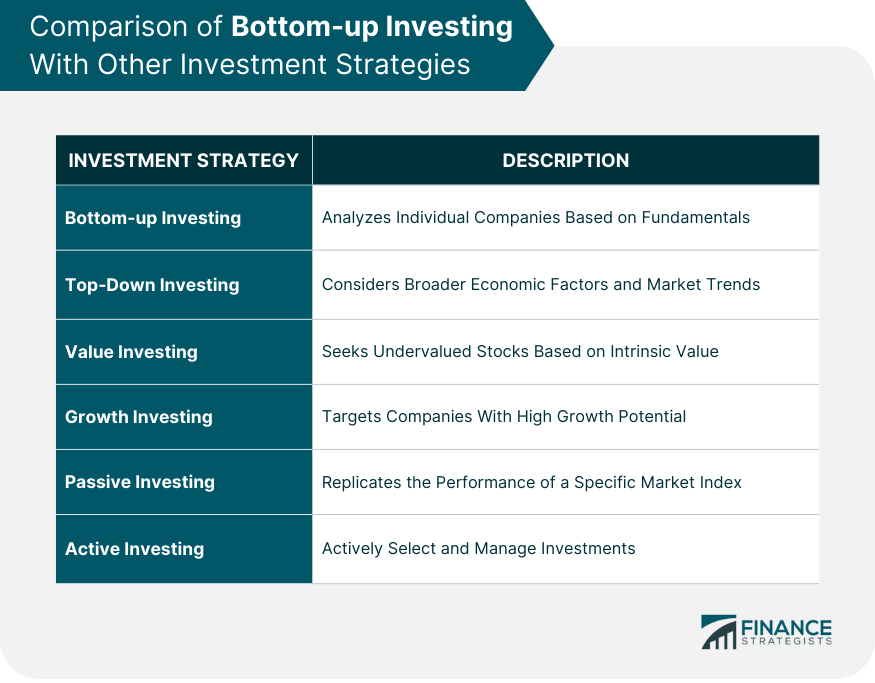
Principles of Bottom-up Investing
Focus on Individual Stocks
Analysis Over Predictions
Long-Term Investment Horizon
Emphasis on Intrinsic Value
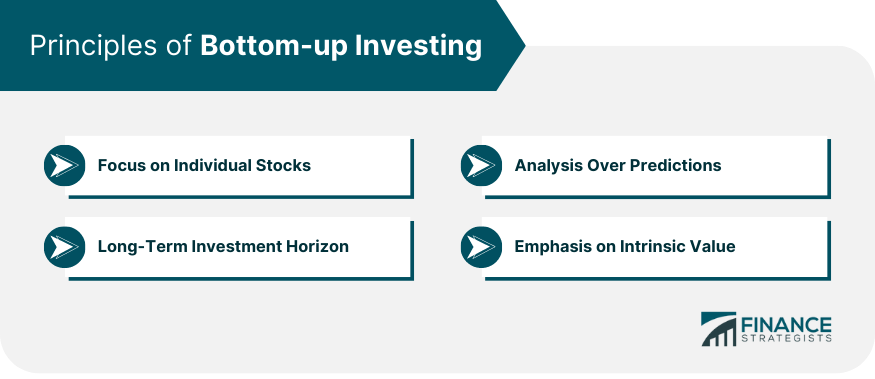
Process of Bottom-up Investing
Researching and Selecting Companies
Role of Financial Statements in Bottom-up Investing
Understanding Business Models and Industries
Portfolio Diversification in Bottom-up Investing
Risk Management in Bottom-up Investing
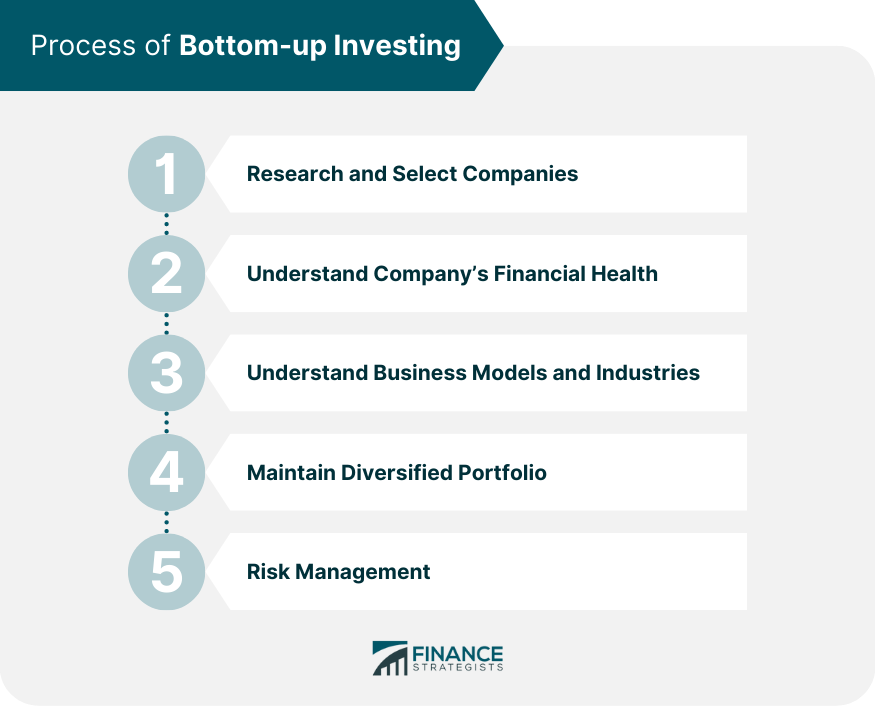
Tools and Techniques in Bottom-up Investing
Fundamental Analysis
Ratio Analysis
Cash Flow Analysis
Earnings Analysis
Qualitative Analysis
Management Evaluation
Market Position
Competitive Advantage
Technical Analysis in Bottom-up Investing
Software and Platforms for Bottom-up Investing
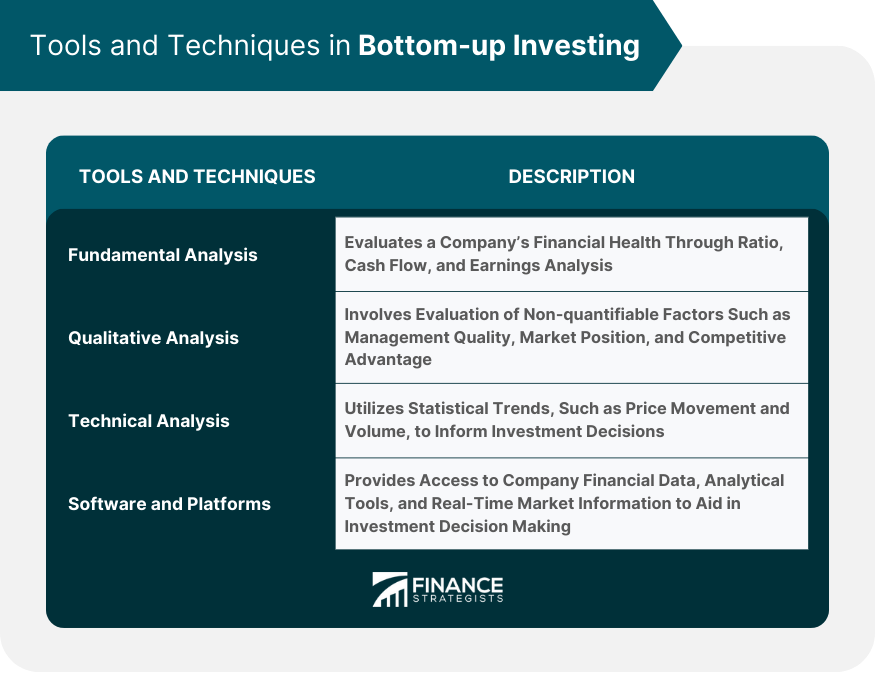
Advantages and Disadvantages of Bottom-up Investing
Advantages
Disadvantages
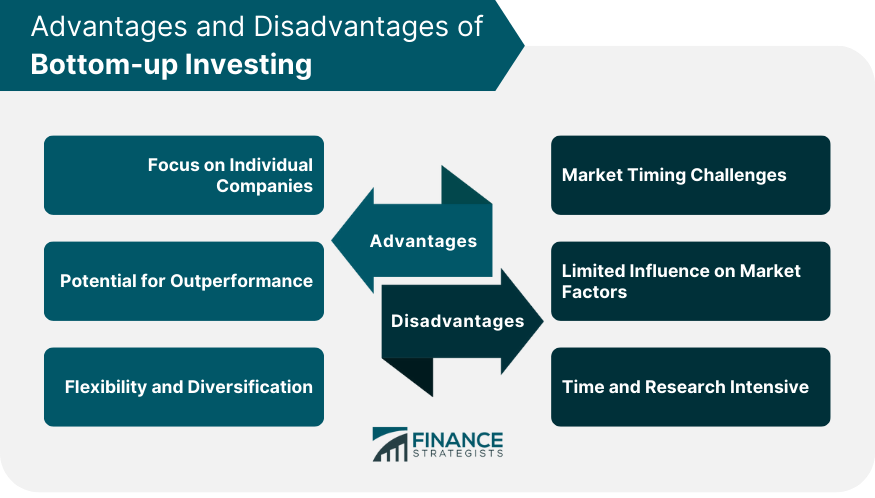
Bottom-up Investing in Different Markets
Conclusion
Bottom-up Investing FAQs
Bottom-up investing is an investment approach that focuses on the analysis of individual companies, instead of the broader market or sector trends. Investors using this strategy believe that good companies can perform well irrespective of market conditions.
The key difference between bottom-up and top-down investing lies in their focus. While bottom-up investing starts with the analysis of individual companies, top-down investing begins with an examination of the overall economy or sector before looking at individual companies.
The key principles of bottom-up investing include focusing on individual stocks, basing decisions on in-depth analysis rather than predictions, having a long-term investment horizon, and emphasizing the intrinsic value of a company.
The main advantages of bottom-up investing include the potential for high returns if undervalued stocks are identified and less exposure to market volatility. However, this approach can be time-consuming and carries the risk of missing broader market or industry trends.
Yes, while traditionally used for stock investing, the principles of bottom-up investing can be applied to other asset classes like bonds, commodities, and even cryptocurrencies. The focus remains on understanding the fundamentals of the individual asset rather than the broader market conditions.
True Tamplin is a published author, public speaker, CEO of UpDigital, and founder of Finance Strategists.
True is a Certified Educator in Personal Finance (CEPF®), author of The Handy Financial Ratios Guide, a member of the Society for Advancing Business Editing and Writing, contributes to his financial education site, Finance Strategists, and has spoken to various financial communities such as the CFA Institute, as well as university students like his Alma mater, Biola University, where he received a bachelor of science in business and data analytics.
To learn more about True, visit his personal website or view his author profiles on Amazon, Nasdaq and Forbes.











